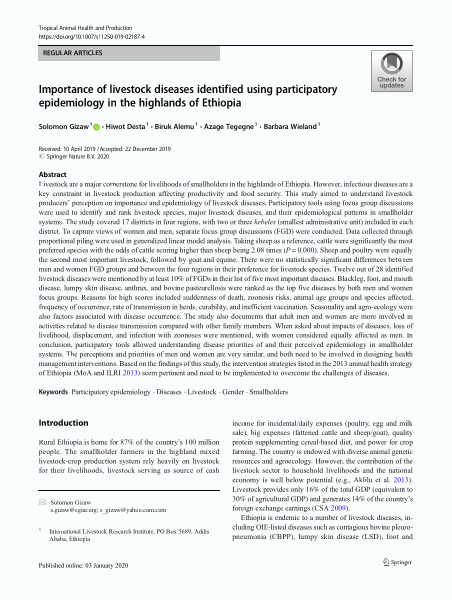Importance of livestock diseases identified using participatory epidemiology in the highlands of Ethiopia
Abstract
Livestock are a major cornerstone for livelihoods of smallholders in the highlands of Ethiopia. However, infectious diseases are a key constraint in livestock production affecting productivity and food security. This study aimed to understand livestock producers’ perception on importance and epidemiology of livestock diseases. Participatory tools using focus group discussions were used to identify and rank livestock species, major livestock diseases, and their epidemiological patterns in smallholder systems. The study covered 17 districts in four regions, with two or three kebeles (smallest administrative unit) included in each district. To capture views of women and men, separate focus group discussions (FGD) were conducted. Data collected through proportional piling were used in generalized linear model analysis. Taking sheep as a reference, cattle were significantly the most preferred species with the odds of cattle scoring higher than sheep being 2.08 times (P = 0.000). Sheep and poultry were equally the second most important livestock, followed by goat and equine. There were no statistically significant differences between men and women FGD groups and between the four regions in their preference for livestock species. Twelve out of 28 identified livestock diseases were mentioned by at least 10% of FGDs in their list of five most important diseases. Blackleg, foot, and mouth disease, lumpy skin disease, anthrax, and bovine pasteurellosis were ranked as the top five diseases by both men and women focus groups. Reasons for high scores included suddenness of death, zoonosis risks, animal age groups and species affected, frequency of occurrence, rate of transmission in herds, curability, and inefficient vaccination. Seasonality and agro-ecology were also factors associated with disease occurrence. The study also documents that adult men and women are more involved in activities related to disease transmission compared with other family members. When asked about impacts of diseases, loss of livelihood, displacement, and infection with zoonoses were mentioned, with women considered equally affected as men. In conclusion, participatory tools allowed understanding disease priorities of and their perceived epidemiology in smallholder systems. The perceptions and priorities of men and women are very similar, and both need to be involved in designing health management interventions. Based on the findings of this study, the intervention strategies listed in the 2013 animal health strategy of Ethiopia (MoA and ILRI 2013) seem pertinent and need to be implemented to overcome the challenges of diseases.

